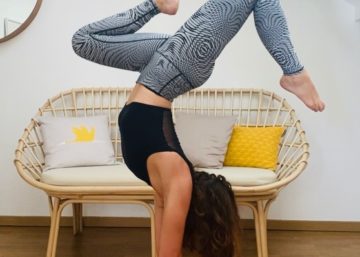Some time ago a platform that lists professionals from various backgrounds, asked me to share my experience in teaching online vinyasa courses. I would like to thank ProntoPro for this collaboration. Find here the details of our exchanges.
You can also find this article published on their website here: https://www.prontopro.fr/bas-rhin/strasbourg/cours-de-yoga-vinyasa#pro-interview.
Yoga classes that invite you to let go
Marion Valence – Yoga teacher in Strasbourg
“Today, I am fortunate to carry out my activities with an audience that is receptive to the inner journey, precisely where the true relationship to oneself, to others and more broadly to the world begins. To go beyond the limits of our mind and our various thoughts, returning to the body seems essential to me. I am passionate, I love to guide and accompany my students on the path towards oneself. This goes through the preparation of the physical body, the teaching of postures and associated techniques but also through the evolution of our mental representations: self-image, acceptance, detachment, benevolence” – Marion Valence.
Marion Valence, 47 years old, is today a yoga teacher, based in Strasbourg. She creates her micro enterprise Pollen of Yoga on May 1st 2017, Labor Day. “The random symbolism of the calendar is amusing because I was about to literally change my life after a career in business. It was a Monday, and on that day I taught my first weekly yoga class at the club where I still practice today. “She recalls. Since then, her activity has continued to grow and she teaches in various establishments such as associations, companies and of course in a club.
Prior to this life, Marion worked in the corporate world for many years, notably in human resources and then in sustainable development. Initially, she studied philosophy and always kept her appetite for novelty. This stimulates her and allows her to express her creativity. Her career path has taken shape according to her desires with a common thread that has remained the same over time, human beings and their environment: the relationship to oneself, to others, to the world and to nature.
“In the company, I felt limited, locked into systems whose values were foreign to me and that no longer suited me. “She confides. At the same time, she had started practicing yoga, which turned her life upside down. After realizing that she had to take care of herself first, the decision to completely change her life became an obvious necessity. To create her small business, she applied to herself what she knew best in terms of change management, to humbly lead a new life transition. While continuing to work full time, she then trained in France and then in Asia, and gradually began to teach different styles of yoga (hatha yoga, vinyasa, yin yoga and sometimes ashtanga which is the basis of her practice).
What is the difference between vinyasa yoga and ashtanga?
A yoga class is built on a sequence of postures called sequencing, which aims to gradually prepare the body to open, stretch and strengthen it. A sequence can focus on a theme, a specific posture or, as in ashtanga, offer a complete practice for the body and mind. Depending on the time available, breathing exercises, meditation, mantra chanting or any other devotional practice, or even philosophy can be integrated. All this richness is intended to calm our mind (the incessant thoughts) and thus raise the level of connection between our body and mind: the term yoga means union. Ashtanga is a complete, normalized and very intense practice, based on a series of predefined postures, practiced to the rhythm of the breath, including what is called Drishti (concentration through the gaze).
The term vinyasa literally means a sequence of steps. Vinyasa is a style of yoga borrowed from ashtanga and hatha yoga (postural yoga), where the postures are freely linked in a continuous flow. The sequencing of a vinyasa class is at the initiative of the teacher. A vinyasa class is therefore very variable depending on the teacher and the needs of students. I really like the creativity of a vinyasa class. I make my sequences to integrate them into a flow where pedagogical variations follow one another, for example around families of postures or new transitions. The idea is to put my students on their way to more elaborate postures, while remaining in the fluidity of movement. I use a lot of music, usually beautifully revisited mantra chants. This immediately creates a special atmosphere, and for me it is a form of ritualization very suitable for studio practice.
What do you think of the online vinyasa yoga classes?
At first I was reluctant and I was really pleasantly surprised. In my classes, I’m used to giving a lot of explanations to get into the postures, to take the right alignments and to succeed in doing the sequences, all while showing the postures simultaneously. And this is a real asset for online classes where the students have much less visual cues (the other practitioners) than in a regular class. So the transition to online teaching was fairly easy and natural. During the confinement, I noticed how vital it was for most of us to stay connected, to keep practicing together no matter what the context. And in fact, the energy of a group, the human warmth and the conniving glances pass through a screen and it was wonderful to experience that.
Since then, I continue to teach online, sometimes also in hybrid courses (simultaneously online and classroom), which is even more demanding for a teacher. The only downside is the verbal adjustment of the students. Indeed, when the group is too large, it is almost impossible to correct the students, except to have several screens to see everyone at the same time without having to scroll. A teacher’s ability to teach, demonstrate and correct students at the same time really makes the difference between an online yoga class and a simple video where students can do anything, or even risk injury…
How is a vinyasa yoga class for beginners?
In my opinion, the practice of vinyasa is not suitable for beginners. It is preferable to start with postural practice like hatha yoga or Iyengar in order to know the postures and alignments associated, before even imagining being able to link them in the dynamics of a flow.
What are the benefits of vinyasa yoga for the body?
The benefits of yoga are many and there is a lot of literature on the subject. Beyond the benefits related to any sport practice, if I had to mention just one it would be the development of body awareness. Everything starts from there, I feel, I am aware of my body and I take care of it. As far as vinyasa is concerned, the benefits are more or less the same. Concentration, elasticity and strengthening of the body may be more important. There are several forms of yoga practices and each one contributes in its own way. Some focus on postures, movement, breath or concentration, others combine the whole. It is all about desires and sensitivities, everyone has its own practice.
Finally, the energy released by the teacher is essential and in the end it is simply a question of resonance with yours… The easiest way is to try the experience by joining my online courses. Subscribe to my newsletter to receive the information (link at the bottom of the page) https://www.pollenofyoga.com/



